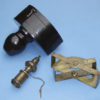Description
|
UNUSUAL SURVEYING RECTANGLES, Italian, c. early 18th c. Constructed somewhat like a graphometer, but in a cage-work construction incorporating the sight vanes, this all-brass instrument measures 6-1/8″ x 3-1/2″ x 2″ (16 x 9 x 5 cm) with a 4-7/8″ tall staff mount. The main plate has a semicircular scale divided every degree from 0 to 180, with stamped numerals every 10°. Opposing slit sight vanes rise at each end, and are joined at their tops with a brass plate including a smaller semicircle divided every quarter hour from 9 “am” through 12 to 3 “pm.” Within this rectangle pivots the smaller “alidade” rectangle, with its opposed slit vanes, inset steel pointer reading against the large semicircle, and finely shaped brass “fleur-de-lys” pointer reading against the upper, smaller semicircle. The scale on the latter is the old fashion of defining directions on a circular hour scale (although this is usually twice-12 hours). The whole assembly can be pinned to a vertical staff mount which has the unusual feature of a bulbous surveying square (with four narrow vertical slits spaced every 90°) built into it. Condition is fine, noting an old splint repair to one sight, and the brass darkened and stained. The whole is contained in a recent fitted wood case lined in chamois leather. This unusual early instrument was found in, and probably made in, Northern Italy, perhaps in Brescia or Bergamo in Lombardy, c. 1730. We have seen no other instrument like it. |
Ask the Dealer
Dealer information
 TESSERACT
TESSERACT
David and Yola Coffeen both have enjoyed academic careers, as planetary astronomer and as linguist/educator. But since 1982 (yes, 1982!) they have been full-time dealers in early scientific and medical instruments, under the name Tesseract. Selling primarily by catalogue (over 100 issued so far) they also have a web presence at www.etesseract.com, and can be contacted at [email protected].










